Deep Regression Prediction of Rheological Properties of SIS-Modified Asphalt Binders
Abstract
:1. Introduction
2. Experimental Design
2.1. SIS-Modified Binder Production
2.2. Dynamic Shear Rheometer (DSR) Test
2.3. Atomic Force Microscope (AFM)
2.4. Deep Learning
2.4.1. Data Matching
2.4.2. Data Preprocessing
2.4.3. Data Augmentation
2.4.4. Train-Overview of Deep Learning Architecture
2.4.5. Train-Applied Architecture (Deep Regression)
2.4.6. Evaluation
3. Results and Discussions
3.1. Dynamic Shear Rheometer (DSR) Test
3.2. AFM Image Analysis
3.3. Prediction of Rheological Properties Using Deep Regression Model
4. Summary and Conclusions
- The addition of SIS into asphalt binder could significantly increase the G*/sin δ at a high-temperature, which could ensure better rutting resistance of asphalt binder;
- The microstructural changes such as bee-like structure and oval shape depending on SIS contents were observed on AFM images, and these properties correlate with the rutting resistance measured by the DSR test;
- In the training and validation process, different training results were presented depending on deep regression architectures, indicating that the type of architecture affects prediction performance on the rheological value measured by the DSR test;
- Even though the linear regression layer was added to the existing architecture considering the quantity prediction, it was concluded that the linear regression models (LR model) could not guarantee a better performance to predict the value;
- Mean absolute percentage error (MAPE) was considered to have the best performance for the evaluation of prediction results in this study;
- Based on the prediction result of VGG16, which placed the highest rank from the MAPE perspective, it was found that the predicted value generated by the developed model showed confusion between the actual value and the adjacent value. This tendency paradoxically indicated the ability of the model to identify the relation between the AFM images and G*/sin δ values related to the binder performance;
- Future work will focus on the development of a more general deep regression model for predicting G*/sin δ according to the change of additive types.
Author Contributions
Funding
Conflicts of Interest
References
- Loeber, L.; Muller, G.; Morel, J.; Sutton, O. Bitumen in colloid science: A chemical, structural and rheological approach. Fuel 1998, 77, 1443–1450. [Google Scholar] [CrossRef]
- Zhang, H.L.; Wang, H.C.; Yu, J.Y. Effect of aging on morphology of organo-montmorillonite modified bitumen by atomic force microscopy: Effect of aging on morphology of OMMT modified bitumen by AFM. J. Microsc. 2011, 242, 37–45. [Google Scholar] [CrossRef] [PubMed]
- Das, P.K.; Baaj, H.; Tighe, S.; Kringos, N. Atomic force microscopy to investigate asphalt binders: A state-of-the-art review. Road Mater. Pavement Des. 2016, 17, 693–718. [Google Scholar] [CrossRef]
- Zhang, F.; Hu, C.; Zhang, Y. The research for SIS compound modified asphalt. Mater. Chem. Phys. 2018, 205, 44–54. [Google Scholar] [CrossRef]
- Kim, H.H.; Mazumder, M.; Lee, M.S.; Lee, S.J. Evaluation of High-Performance Asphalt Binders Modified with SBS, SIS, and GTR. Adv. Civil Eng. 2019, 2019. [Google Scholar] [CrossRef]
- Cheraghian, G.; Wistuba, M.P. Ultraviolet aging study on bitumen modified by a composite of clay and fumed silica nanoparticles. Sci. Rep. 2020, 10, 1–17. [Google Scholar] [CrossRef]
- Qian, G.; Yang, C.; Huang, H.; Gong, X.; Yu, H. Resistance to ultraviolet aging of nano-SiO2 and rubber powder compound modified asphalt. Materials 2020, 13, 5067. [Google Scholar] [CrossRef]
- Loeber, L.; Sutton, O.; Morel, J.V.J.M.; Valleton, J.M.; Muller, G. New direct observations of asphalts and asphalt binders by scanning electron microscopy and atomic force microscopy. J. Microsc. 1996, 182, 32–39. [Google Scholar] [CrossRef]
- Jäger, A.; Lackner, R.; Eisenmenger-Sittner, C.; Blab, R. Identification of microstructural components of bitumen by means of atomic force microscopy (AFM). PAMM 2004, 4, 400–401. [Google Scholar] [CrossRef]
- MASSON, J.F.; Leblond, V.; Margeson, J. Bitumen morphologies by phase-detection atomic force microscopy. J. Microsc. 2006, 221, 17–29. [Google Scholar] [CrossRef] [Green Version]
- Fischer, H.R.; Dillingh, E.C.; Hermse, C.G.M. On the micro-structure of bituminous binders. Road Mater. Pavement Des. 2014, 15, 1–15. [Google Scholar] [CrossRef]
- Das, P.K.; Kringos, N.; Wallqvist, V.; Birgisson, B. Micro-mechanical investigation of phase separation in bitumen by combining atomic force microscopy with differential scanning calorimetry results. Road Mater. Pavement Des. 2013, 14 (Suppl. 1), 25–37. [Google Scholar] [CrossRef]
- Kim, H.H.; Mazumder, M.; Lee, S.J. Micromorphology and rheology of warm binders depending on aging. J. Mater. Civil Eng. 2017, 29, 04017226. [Google Scholar] [CrossRef]
- Kim, H.H.; Mazumder, M.; Torres, A.; Lee, S.J.; Lee, M.S. Characterization of CRM binders with wax additives using an atomic force microscopy (AFM) and an optical microscopy. Adv. Civil Eng. Mater. 2017, 6, 504–525. [Google Scholar] [CrossRef]
- Ciregan, D.; Meier, U.; Schmidhuber, J. Multi-column deep neural networks for image classification. In Proceedings of the 2012 IEEE conference on computer vision and pattern recognition, Providence, RI, USA, 16–21 June 2012; pp. 3642–3649. [Google Scholar]
- LeCun, Y.; Bengio, Y.; Hinton, G. Deep learning. Nature 2015, 521, 436–444. [Google Scholar] [CrossRef]
- Chan, T.H.; Jia, K.; Gao, S.; Lu, J.; Zeng, Z.; Ma, Y. PCANet: A simple deep learning baseline for image classification? IEEE Trans. Image Process. 2015, 24, 5017–5032. [Google Scholar] [CrossRef] [Green Version]
- Szegedy, C.; Toshev, A.; Erhan, D. Deep neural networks for object detection. Adv. Neural Inf. Process. Syst. 2013, 26, 2553–2561. [Google Scholar]
- Ouyang, W.; Wang, X.; Zeng, X.; Qiu, S.; Luo, P.; Tian, Y.; Li, H.; Yang, S.; Loy, C.; Tang, X. Deepid-net: Deformable deep convolutional neural networks for object detection. In Proceedings of the IEEE Conference on Computer Vision and Pattern Recognition, Boston, MA, USA, 7–12 June 2015; pp. 2403–2412. [Google Scholar]
- Li, G.; Yu, Y. Deep contrast learning for salient object detection. In Proceedings of the IEEE Conference on Computer Vision and Pattern Recognition, Las Vegas, NV, USA, 26 June–1 July 2016; pp. 478–487. [Google Scholar]
- Toshev, A.; Szegedy, C. Deeppose: Human pose estimation via deep neural networks. In Proceedings of the IEEE Conference on Computer Vision and Pattern Recognition, Columbus, OH, USA, 24–27 June 2014; pp. 1653–1660. [Google Scholar]
- Belagiannis, V.; Rupprecht, C.; Carneiro, G.; Navab, N. Robust optimization for deep regression. In Proceedings of the IEEE International Conference on Computer Vision, Boston, MA, USA, 7–12 June 2015; pp. 2830–2838. [Google Scholar]
- Liu, X.; Liang, W.; Wang, Y.; Li, S.; Pei, M. 3D head pose estimation with convolutional neural network trained on synthetic images. In Proceedings of the 2016 IEEE International Conference on Image Processing (ICIP), Phoenix, AZ, USA, 25–28 September 2016; pp. 1289–1293. [Google Scholar]
- Perez, L.; Wang, J. The effectiveness of data augmentation in image classification using deep learning. arXiv 2017, arXiv:1712.04621. [Google Scholar]
- He, K.; Zhang, X.; Ren, S.; Sun, J. Deep residual learning for image recognition. In Proceedings of the IEEE Conference on Computer Vision and Pattern Recognition, Las Vegas, NV, USA, 26 June–1 July 2016; pp. 770–778. [Google Scholar]
- Buetti-Dinh, A.; Galli, V.; Bellenberg, S.; Ilie, O.; Herold, M.; Christel, S.; Mariia, B.; Igor, P.; Paul, W.; Sand, W.; et al. Deep neural networks outperform human expert’s capacity in characterizing bioleaching bacterial biofilm composition. Biotechnol. Rep. 2019, 22, e00321. [Google Scholar] [CrossRef]
- Krizhevsky, A.; Ilya, S.; Geoffrey, E.H. Imagenet classification with deep convolutional neural networks. Commun. ACM 2017, 60, 84–90. [Google Scholar] [CrossRef]
- LeCun, Y.; Bottou, L.; Bengio, Y.; Haffner, P. Gradient-based learning applied to document recognition. Proc. IEEE 1998, 86, 2278–2324. [Google Scholar] [CrossRef] [Green Version]
- Simonyan, K.; Zisserman, A. Very deep convolutional networks for large-scale image recognition. arXiv 2014, arXiv:1409.1556. [Google Scholar]
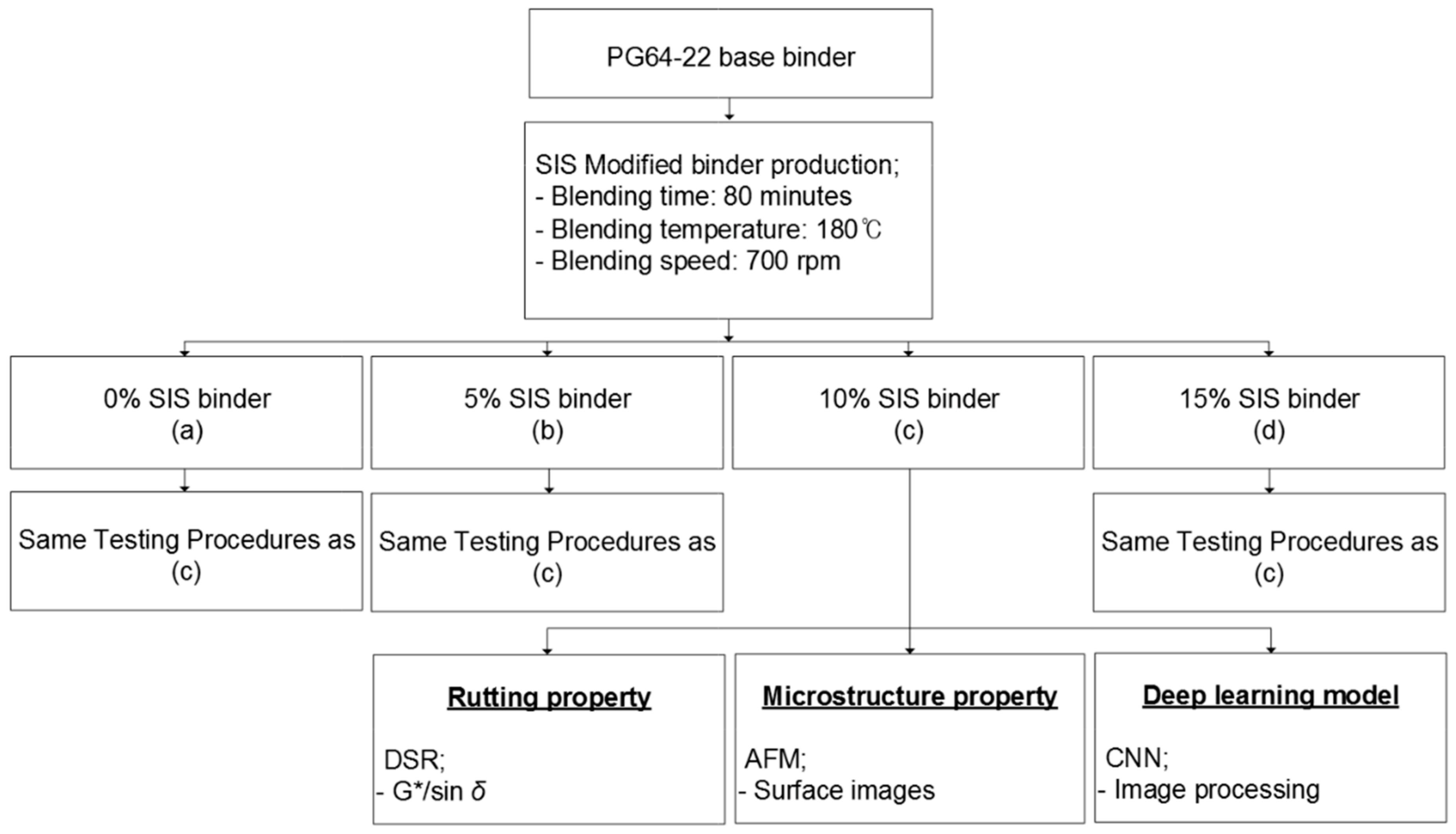
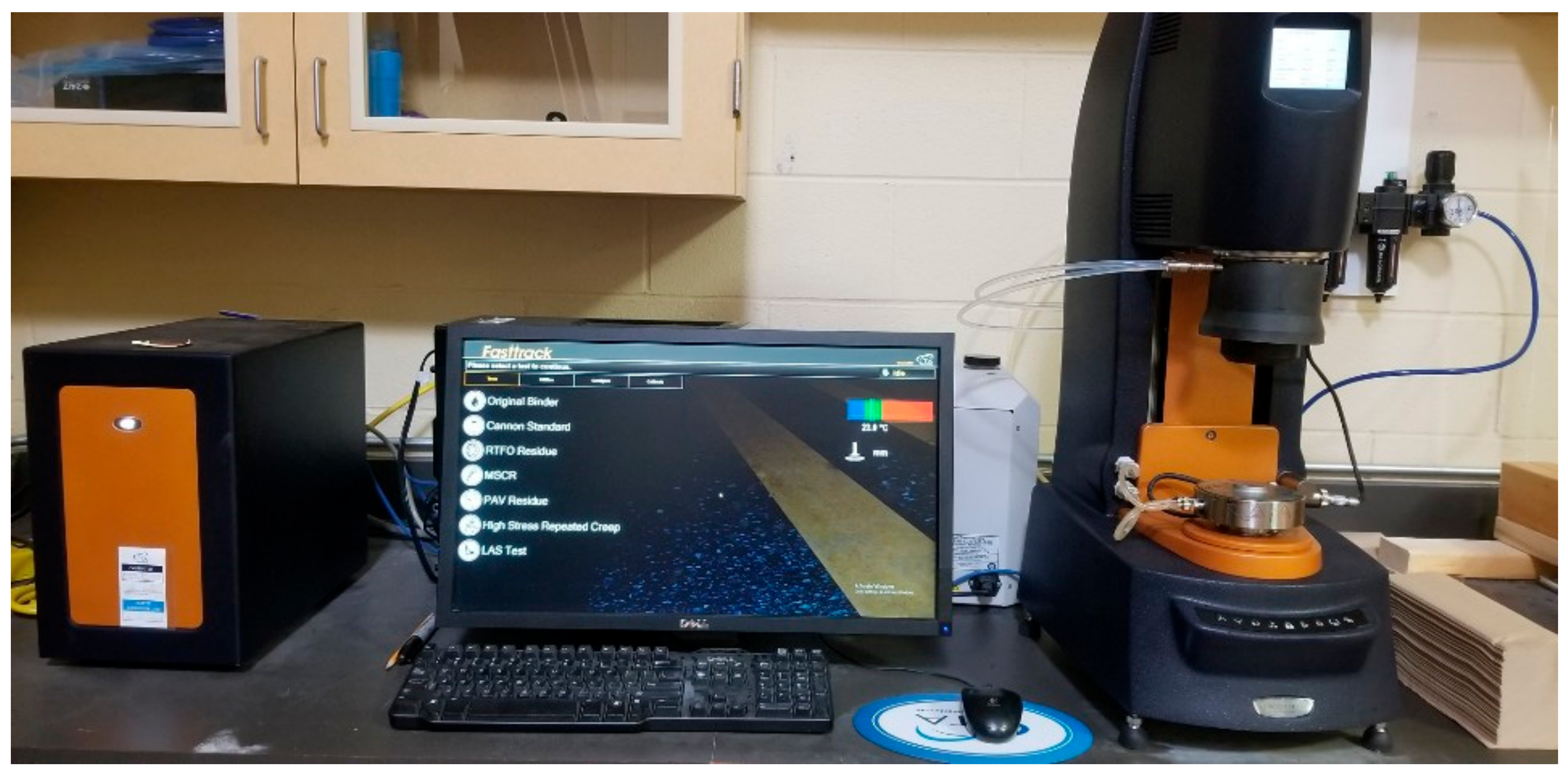
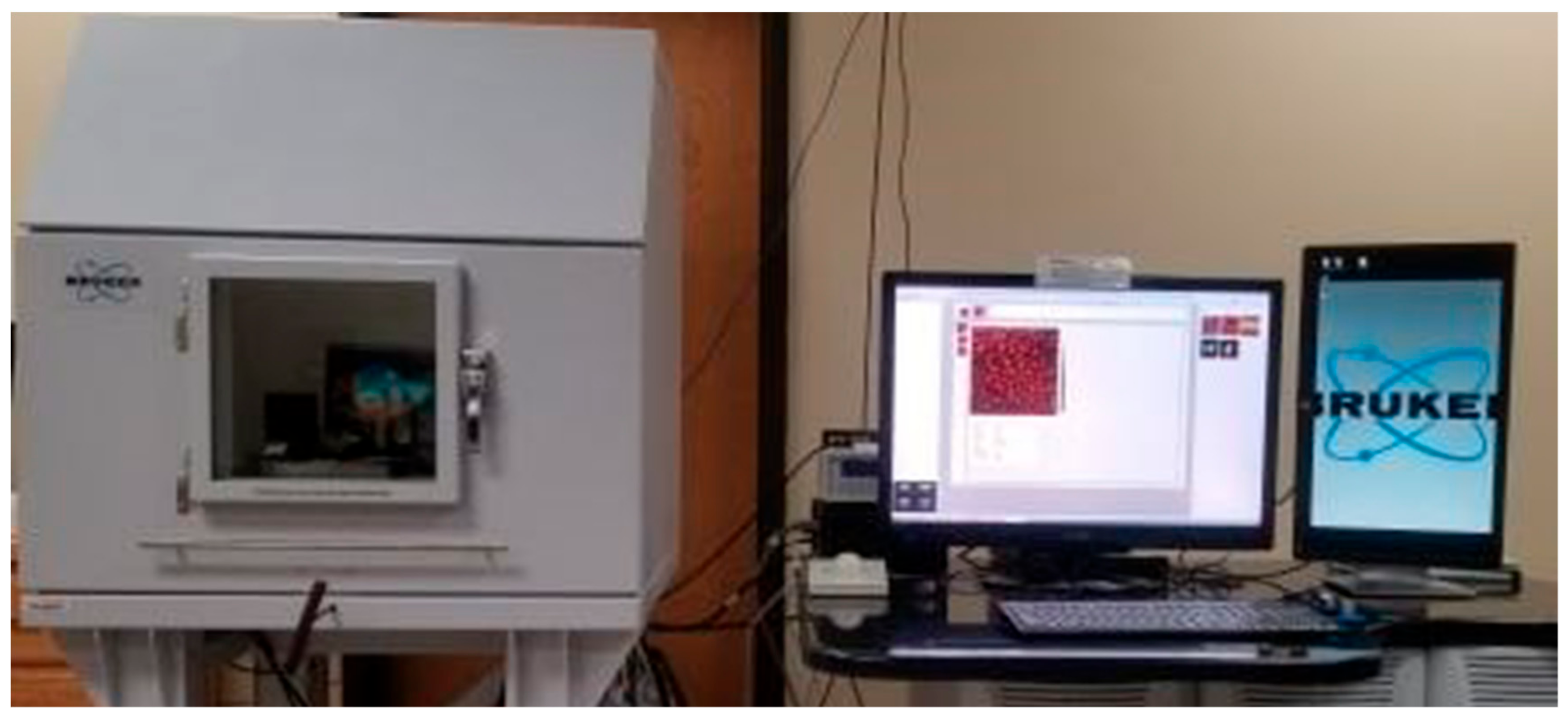
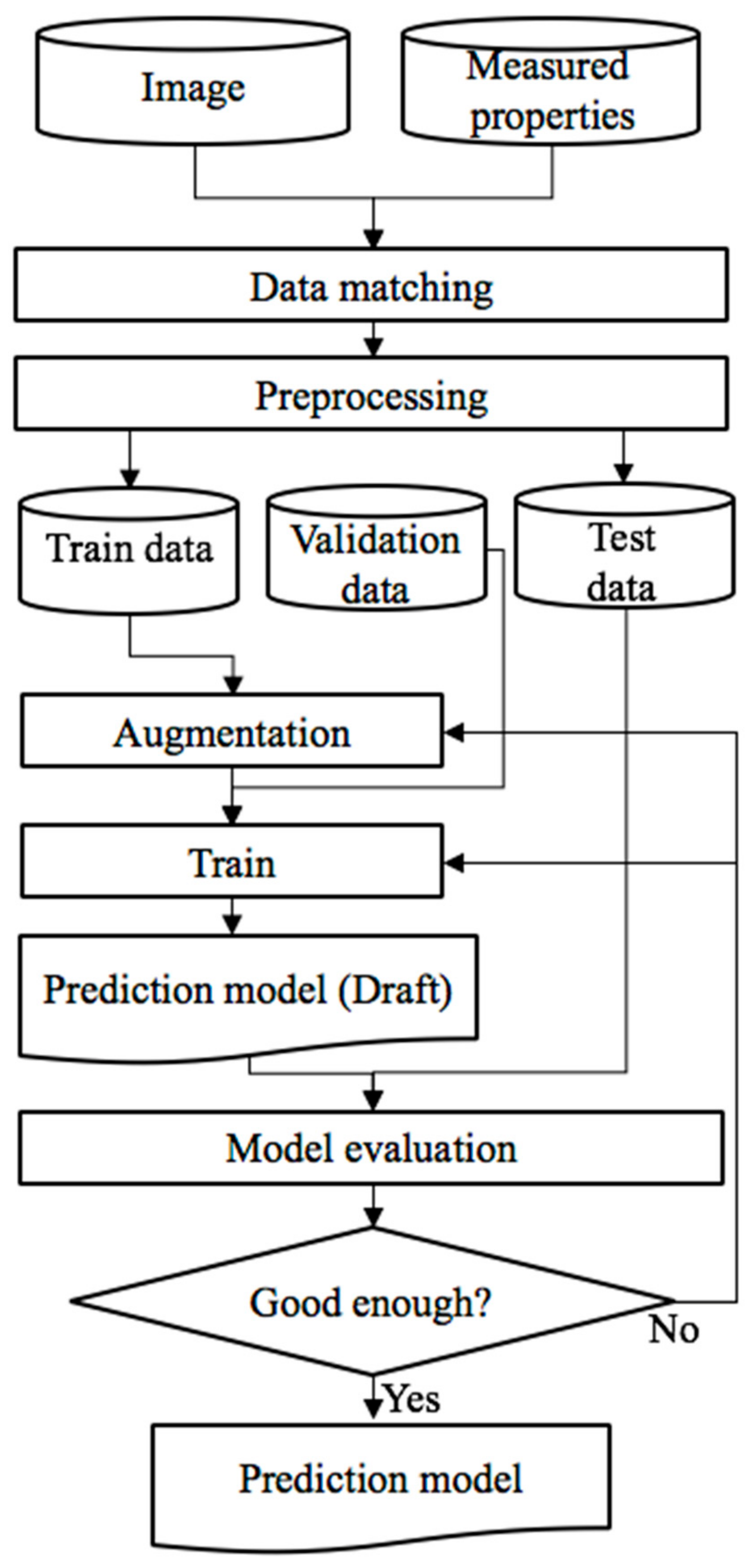
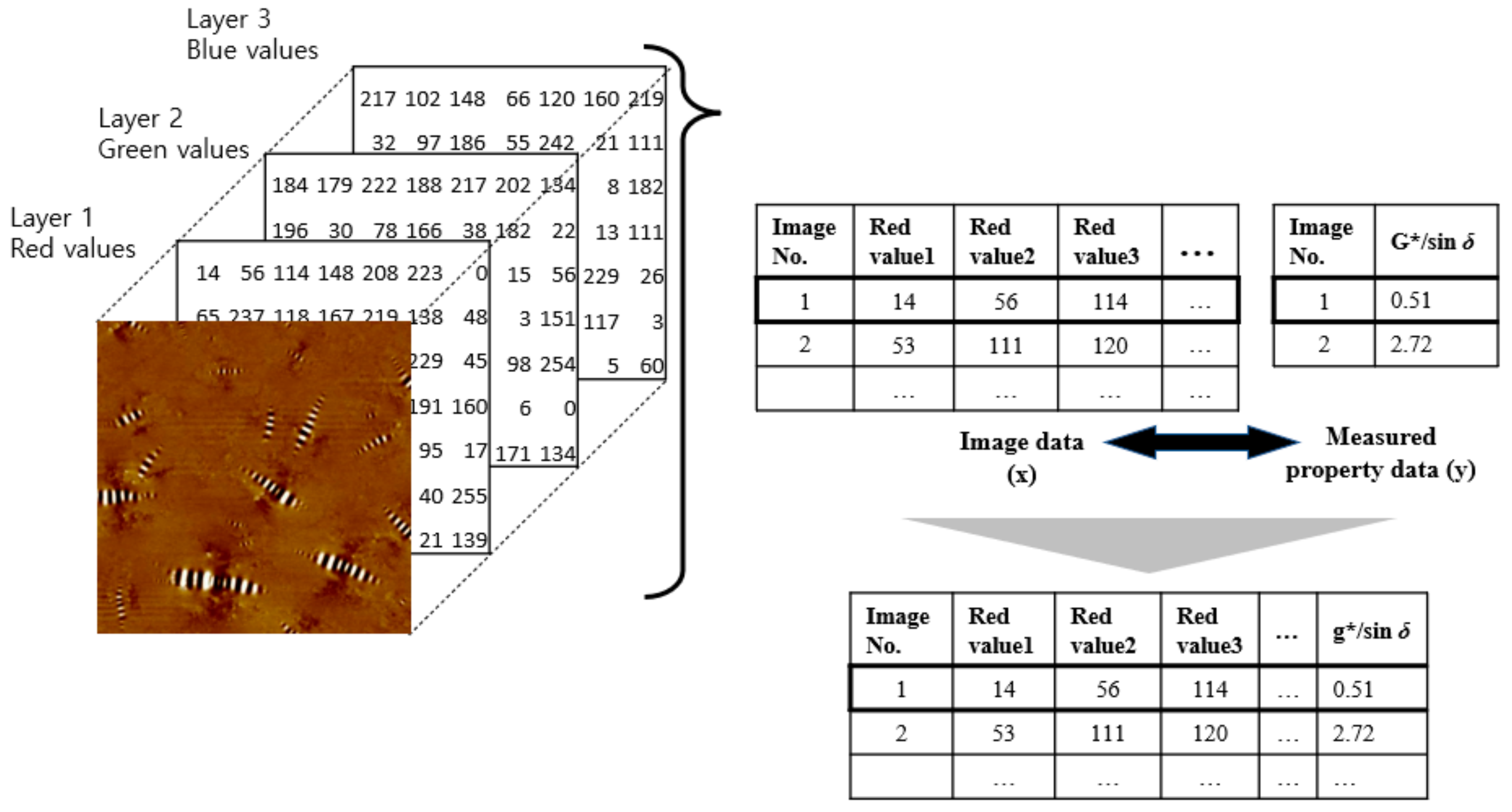
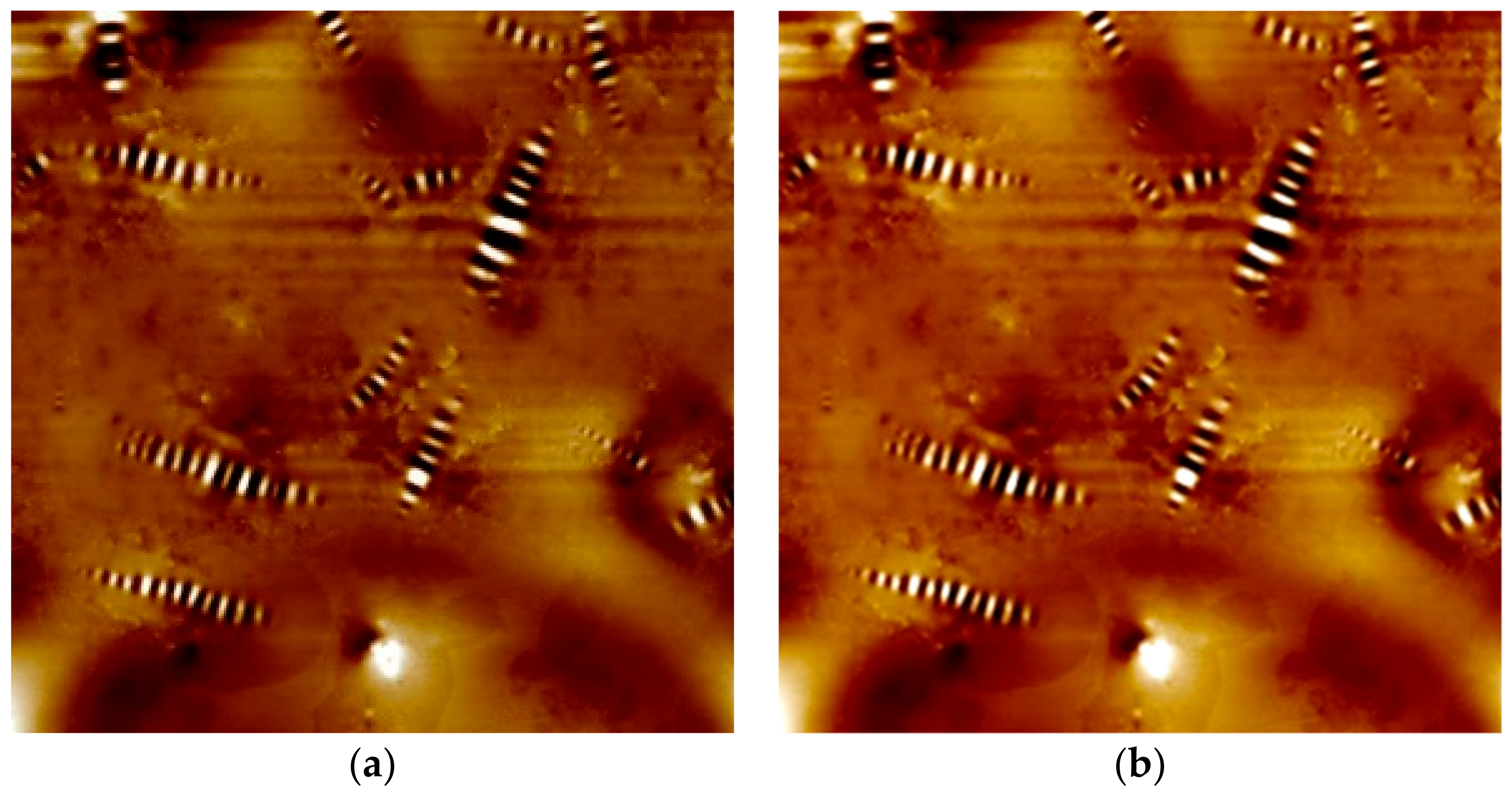
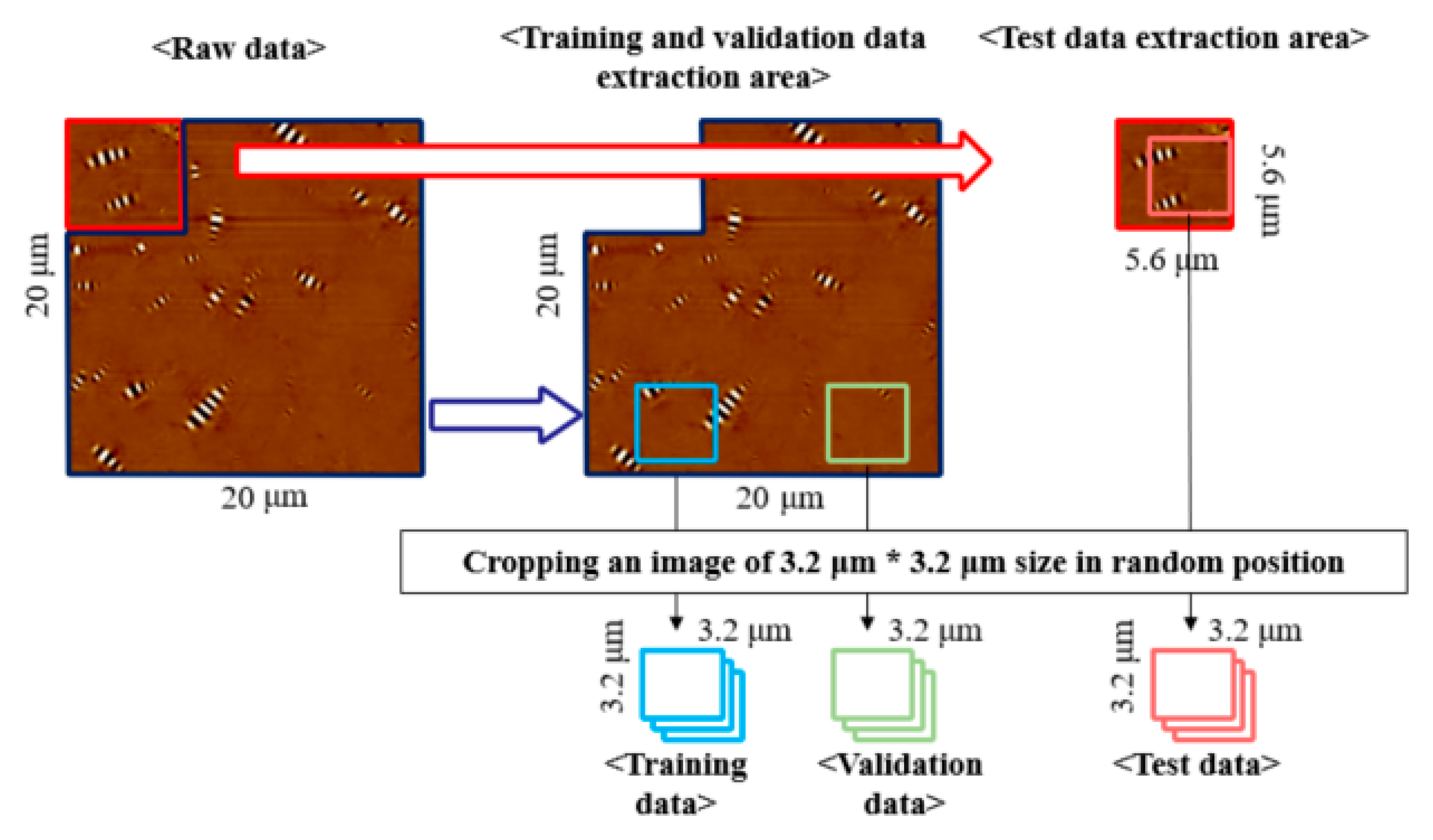





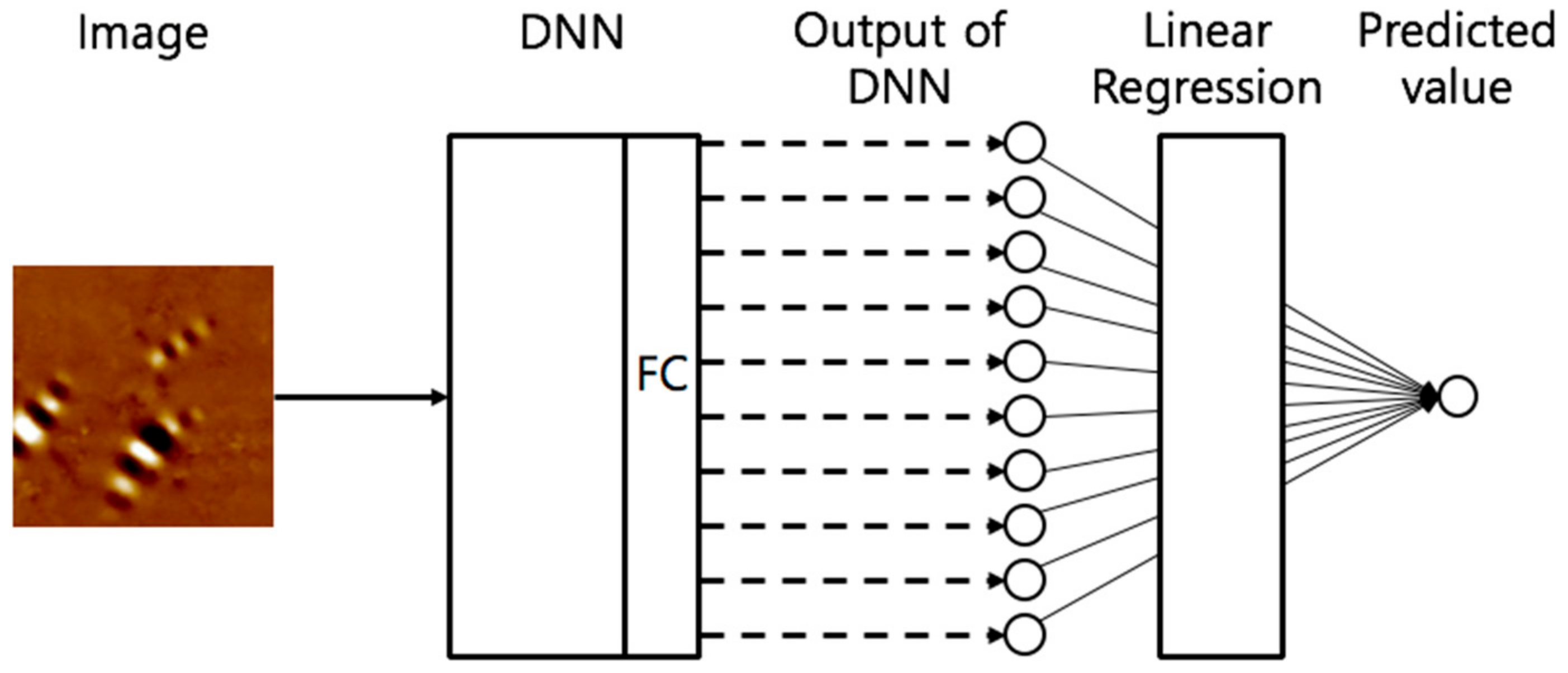
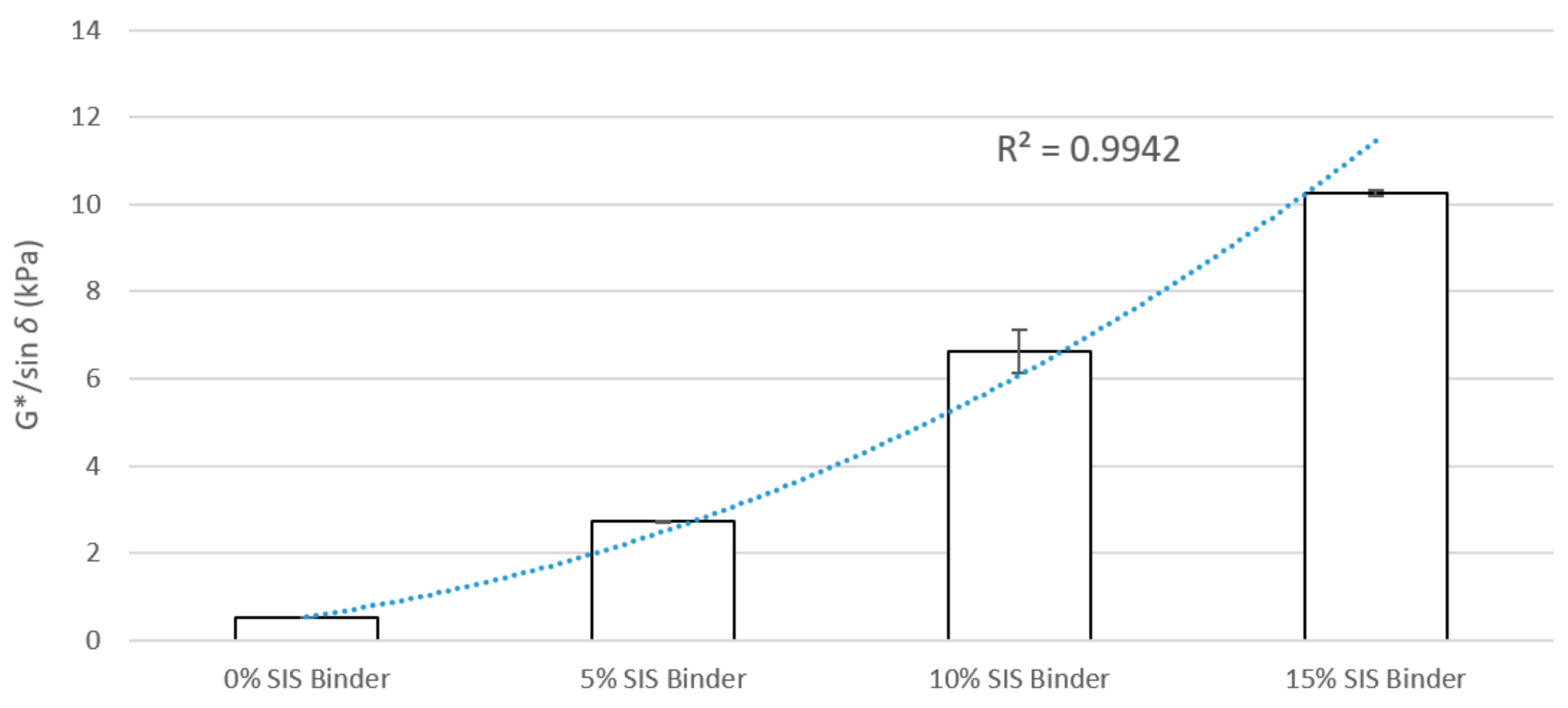

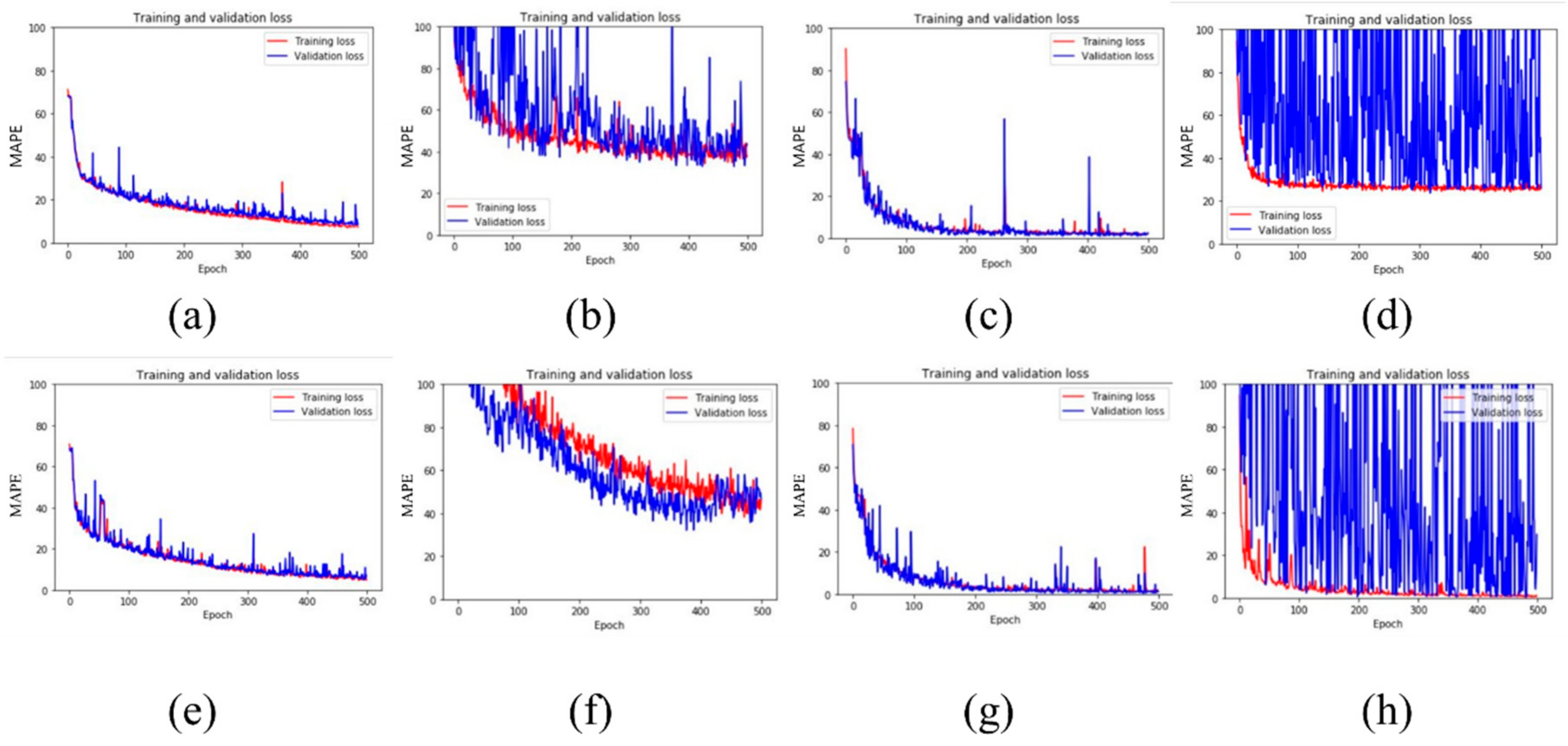

| Aging States | Test Properties | Test Result |
|---|---|---|
| Unaged binder | Viscosity at 135 °C (cP) | 531 |
| G*/sin δ at 64 °C (kPa) | 1.415 | |
| RTFO aged residual | G*/sin δ at 64 °C (kPa) | 2.531 |
| RTFO+PAV aged residual | G*sin δ at 25 °C (kPa) | 2558 |
| Stiffness at −12 °C (MPa) | 287 | |
| m-value at −12 °C | 0.307 |
| Binder Type | Actual Value (G*/sin δ) | LeNet5 | AlexNet | VGG16 | ResNet50 |
| SIS 0% | 0.51 | 0.52 | 0.00 | 0.51 | 0.00 |
| SIS 5% | 2.72 | 2.86 | 2.18 | 2.11 | 2.73 |
| SIS 10% | 6.61 | 3.24 | 4.36 | 5.13 | 6.58 |
| SIS 15% | 10.25 | 8.15 | 6.05 | 6.43 | 8.81 |
| Binder Type | Actual Value (G*/sin δ) | LeNet5+LR | AlexNet+LR | VGG16+LR | ResNet50+LR |
| SIS 0% | 0.51 | 0.51 | 0.40 | 0.51 | 0.51 |
| SIS 5% | 2.72 | 2.91 | 0.94 | 1.70 | 0.98 |
| SIS 10% | 6.61 | 3.78 | 3.24 | 3.37 | 6.70 |
| SIS 15% | 10.25 | 8.90 | 2.26 | 8.16 | 9.26 |
| Architectures | R2 | Rank |
|---|---|---|
| LeNet5 | 0.81 | 7 |
| AlexNet | 0.91 | 2 |
| VGG16 | 0.88 | 4 |
| ResNet50 | 0.96 | 1 |
| LeNet5_LR | 0.85 | 5 |
| AlexNet_LR | 0.59 | 8 |
| VGG16_LR | 0.85 | 5 |
| ResNet50_LR | 0.89 | 3 |
| Actual Value | LeNet5 | AlexNet | VGG16 | ResNet50 | LeNet5+LR | AlexNet+LR | VGG16+LR | ResNet50+LR |
|---|---|---|---|---|---|---|---|---|
| 0.51 | 0.0 | 0.3 | 0.0 | 0.3 | 0.0 | 0.0 | 0.0 | 0.0 |
| 2.72 | 2.0 | 0.9 | 1.1 | 0.0 | 2.4 | 3.7 | 2.1 | 3.7 |
| 6.61 | 12.4 | 6.8 | 4.1 | 0.0 | 10.3 | 12.2 | 12.0 | 5.3 |
| 10.25 | 11.7 | 18.7 | 17.6 | 4.8 | 6.7 | 66.3 | 11.6 | 7.3 |
| Average | 6.5 | 6.7 | 5.7 | 1.3 | 4.9 | 20.6 | 6.4 | 4.1 |
| Rank | 6 | 7 | 4 | 1 | 3 | 8 | 5 | 2 |
| Actual Value | LeNet5 | AlexNet | VGG16 | ResNet50 | LeNet5+LR | AlexNet+LR | VGG16+LR | ResNet50+LR |
|---|---|---|---|---|---|---|---|---|
| 0.51 | 0.02 | 1.00 | 0.00 | 1.00 | 0.00 | 0.22 | 0.00 | 0.00 |
| 2.72 | 0.37 | 0.25 | 0.24 | 0.01 | 0.35 | 0.66 | 0.38 | 0.65 |
| 6.61 | 0.51 | 0.35 | 0.24 | 0.00 | 0.43 | 0.51 | 0.49 | 0.22 |
| 10.25 | 0.22 | 0.41 | 0.37 | 0.14 | 0.14 | 0.78 | 0.21 | 0.11 |
| Average | 0.28 | 0.50 | 0.21 | 0.29 | 0.23 | 0.54 | 0.27 | 0.25 |
| Rank | 5 | 7 | 1 | 6 | 2 | 8 | 4 | 3 |
Publisher’s Note: MDPI stays neutral with regard to jurisdictional claims in published maps and institutional affiliations. |
© 2020 by the authors. Licensee MDPI, Basel, Switzerland. This article is an open access article distributed under the terms and conditions of the Creative Commons Attribution (CC BY) license (http://creativecommons.org/licenses/by/4.0/).
Share and Cite
Ji, B.; Lee, S.-J.; Mazumder, M.; Lee, M.-S.; Kim, H.H. Deep Regression Prediction of Rheological Properties of SIS-Modified Asphalt Binders. Materials 2020, 13, 5738. https://doi.org/10.3390/ma13245738
Ji B, Lee S-J, Mazumder M, Lee M-S, Kim HH. Deep Regression Prediction of Rheological Properties of SIS-Modified Asphalt Binders. Materials. 2020; 13(24):5738. https://doi.org/10.3390/ma13245738
Chicago/Turabian StyleJi, Bongjun, Soon-Jae Lee, Mithil Mazumder, Moon-Sup Lee, and Hyun Hwan Kim. 2020. "Deep Regression Prediction of Rheological Properties of SIS-Modified Asphalt Binders" Materials 13, no. 24: 5738. https://doi.org/10.3390/ma13245738





